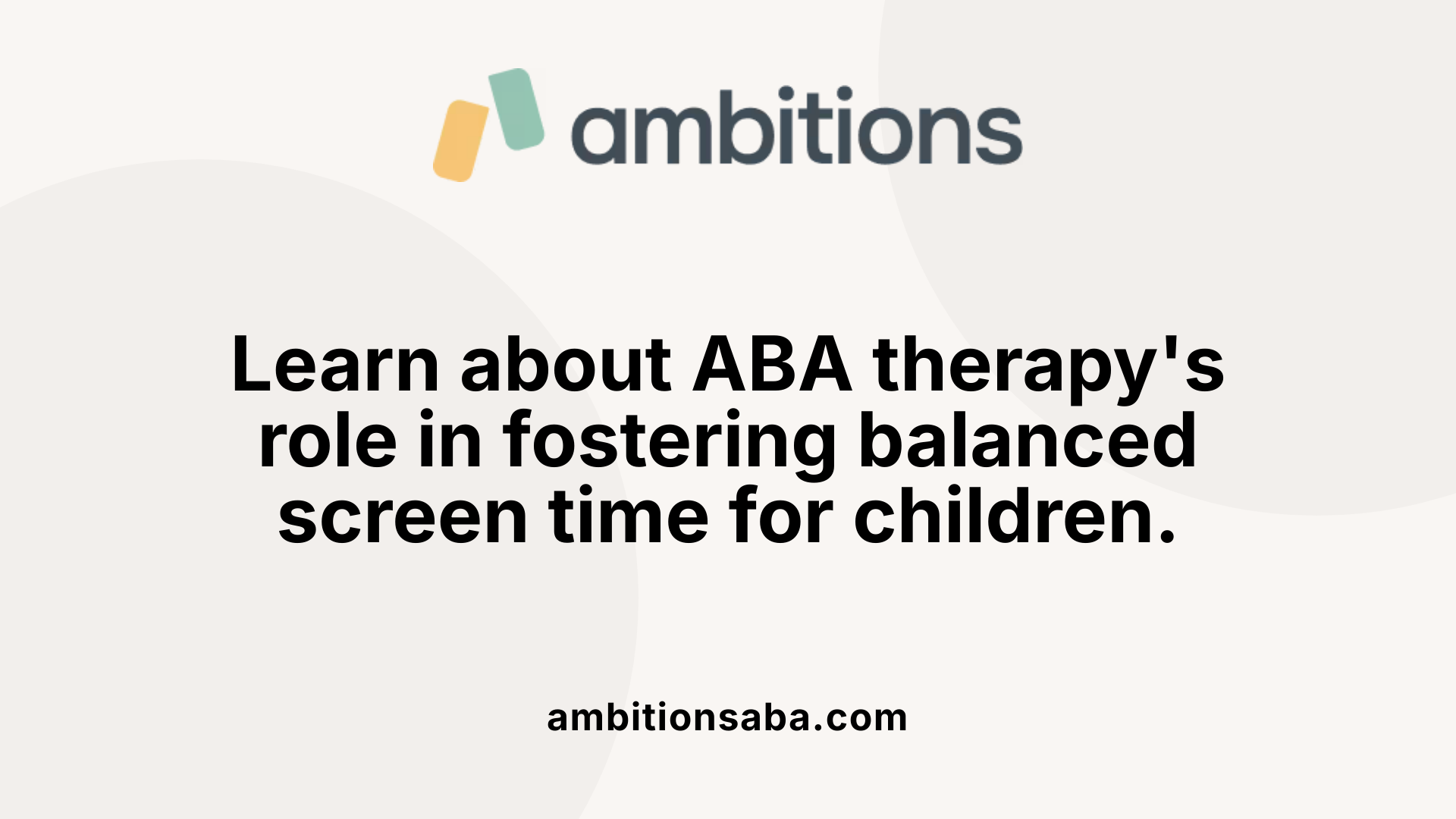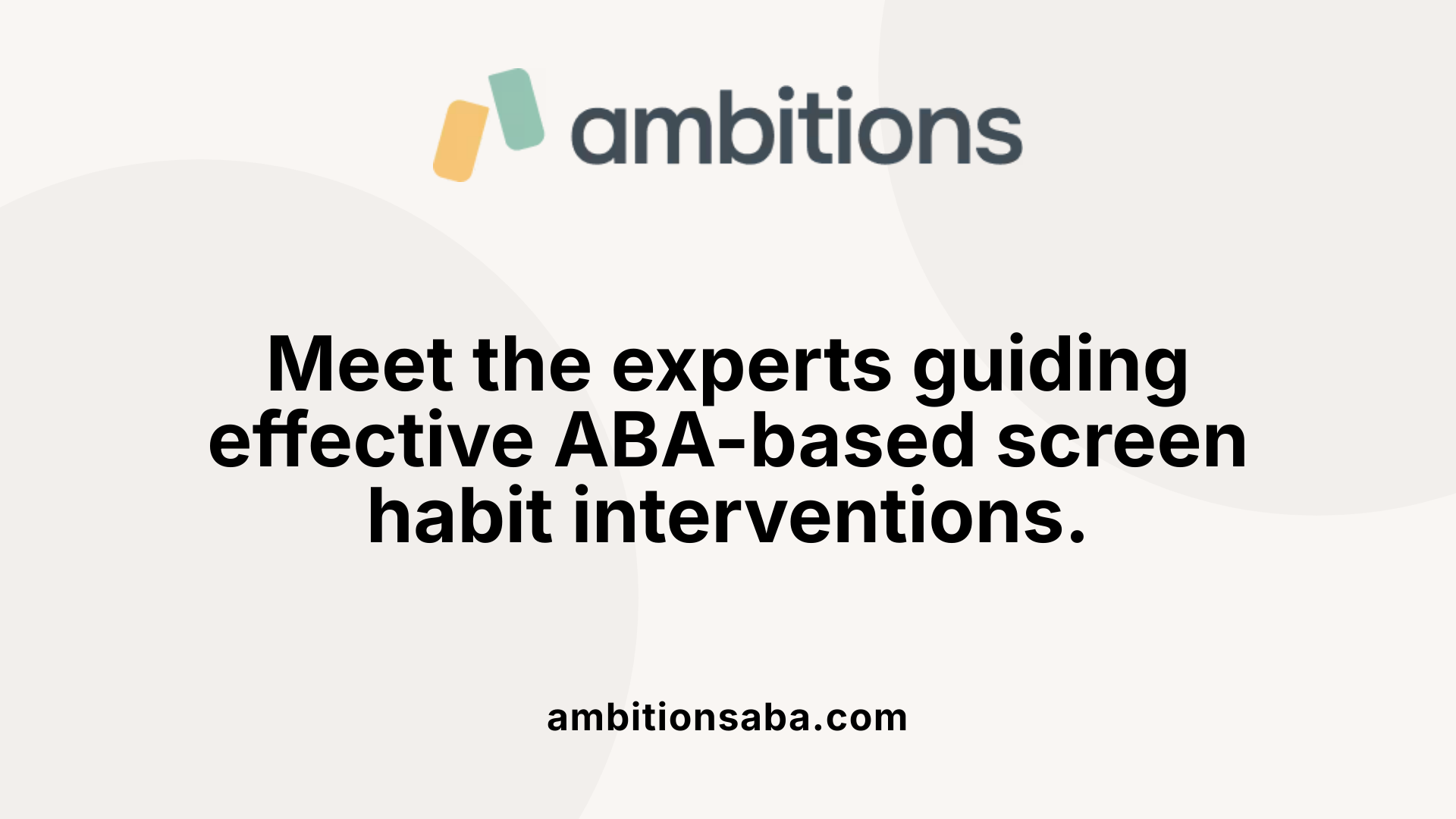Unlocking Excellence in ABA Therapy: Traits, Qualifications, and Standards
The Growing Role of Screens in Neurodiverse Children’s Lives
In an increasingly digital world, screens have become integral to many children's daily experiences, especially for neurodiverse children. For those with autism spectrum disorder and other developmental differences, technology can offer critical tools for communication, learning, and regulation. However, balancing screen time to ensure it supports healthy development requires thoughtful strategies. Behavior analysis provides a roadmap to build positive, adaptive screen habits, enabling children to benefit from technology while avoiding potential pitfalls.
Understanding Applied Behavior Analysis (ABA) Therapy and Its Role in Screen Habits

What is Applied Behavior Analysis (ABA) therapy?
Applied Behavior Analysis (ABA) therapy is a well-established, science-based approach that helps individuals, primarily children with autism spectrum disorder, learn new skills and decrease unwanted behaviors. Using principles of learning and behavior, ABA focuses on enhancing communication, social interactions, and everyday living skills. Interventions involve techniques like positive reinforcement to encourage good behaviors, prompt fading to gradually reduce support, and careful tracking of behavior patterns to guide therapy adjustments.
Behavioral strategies relevant to screen use
ABA therapy can effectively shape screen habits by teaching children how to balance technology use with other activities. Strategies might include setting clear expectations for screen time and rewarding adherence, using gradual transitions to minimize distress when turning screens off, and promoting engagement in alternative, offline activities. The therapy also supports modeling appropriate screen behavior and analyzing triggers or consequences that affect screen use, helping caregivers create supportive, structured routines.
Personalized, ethical approaches in ABA
Modern ABA practices prioritize ethical, individualized treatment plans developed by qualified behavior analysts (BCBAs). Therapy is tailored to each child's unique strengths, interests, and developmental needs, ensuring respect and collaboration. Play-based and naturalistic methods are favored to help skills learned during sessions generalize to real-life settings such as home or school. Continuous data collection and progress monitoring ensure that screen habit interventions remain effective and supportive of the child’s overall well-being.
How ABA Therapy Supports Neurodiverse Children in Developing Healthy Screen Habits

Teaching essential skills through ABA
ABA therapy is highly effective for supporting neurodiverse children, including those with autism, by teaching crucial skills that enhance daily functioning. Through structured techniques like positive reinforcement, it addresses communication, social interaction, and self-care behaviors. This method can help children understand and navigate screen time in a balanced way, reinforcing appropriate use and guiding them toward alternative positive activities.
Tailoring screen time for developmental needs
Each child’s developmental profile is unique, especially among neurodiverse populations. ABA practitioners design screen time guidelines tailored to individual needs, recognizing that abrupt changes in screen use can cause distress. They support gradual adjustments and focus on the quality rather than just the quantity of screen engagement. This approach helps children feel more in control and reduces meltdowns while promoting healthier habits.
Role of individualized intervention plans
Personalized intervention plans are central to ABA therapy’s success in managing screen time. These plans integrate the child’s specific behavioral patterns and learning style, ensuring strategies align with their developmental level. By incorporating screen-based activities that also teach social skills and independence, ABA therapy encourages children to use technology as a supportive learning tool rather than a sole coping mechanism.
In summary, ABA therapy equips neurodiverse children with the tools needed to establish healthy screen habits through skill-building, personalized support, and gradual habit formation, ultimately enhancing their overall well-being and social participation.
Key Professionals Behind ABA Therapy and Screen Habit Interventions

Roles of BCBAs, Therapists, and Support Staff
Applied Behavior Analysis (ABA) therapy is delivered by a team of specialized professionals. Board Certified Behavior Analysts (BCBAs) lead therapy design and oversight. These highly trained experts assess individual needs and create personalized programs. Registered behavior technicians and therapists implement these plans through direct engagement with children, teaching communication, social, and functional skills. Support staff assist in the day-to-day delivery of interventions, ensuring consistent application.
Importance of Training and Credentials
Qualified ABA providers hold specific certifications that demonstrate their expertise. BCBAs earn certification by demonstrating proficiency in behavior analytic principles and supervised practical experience. Many organizations also seek accreditation from bodies like the Behavior Health Center of Excellence (BHCOE), ensuring providers meet rigorous standards. This credentialing assures parents and caregivers that the team uses evidence-based, ethical approaches rooted in science.
Caregiver Involvement and Team Collaboration
Effective ABA therapy transcends the clinical setting by involving caregivers in the learning process. Providers offer training to parents and families so that skills taught during sessions can generalize to home and community environments. Collaboration among professionals, caregivers, and educators forms a supportive network that promotes consistent progress. This team approach is especially valuable when managing screen habits in neurodiverse children, balancing therapeutic goals with technology use in daily life.
Core Elements of ABA Programs Tailored to Screen Use

What are the key components involved in an ABA therapy program?
Applied Behavior Analysis (ABA) programs start with a detailed assessment to identify the individual's needs and strengths. This assessment helps in setting personalized, meaningful goals that focus on socially significant skills, such as managing screen use effectively.
Positive reinforcement and prompting are central strategies in ABA. These techniques encourage desirable behaviors, like engaging in balanced screen time, by providing rewards or cues that support learning new habits. For example, a child might receive praise or a preferred activity for following agreed screen time limits.
Data monitoring plays a vital role in ABA programs. Careful collection of data on screen use, behavior frequency, and skill mastery allows for ongoing evaluation and adjustments to the intervention plan. This ensures that strategies are effective and goals remain relevant as the child progresses.
Generalization of skills outside therapy settings is also a core focus. ABA emphasizes teaching children how to apply new behaviors in various contexts—like at home or school—to foster independence and consistency.
Parent training and consistency are crucial to success. Caregivers learn how to implement ABA techniques at home, creating a stable environment with clear rules around screens. When parents model healthy screen habits and maintain consistent guidelines, children are more likely to develop self-monitoring skills and balanced routines.
In summary, ABA therapy programs for managing screen habits involve comprehensive assessment, evidence-based strategies such as positive reinforcement and prompting, continuous data-driven adjustments, skill generalization, and active parent collaboration. This structured yet flexible approach helps neurodiverse children develop healthier screen use patterns tailored to their unique needs.
Balancing the Benefits and Risks of Screen Time for Neurodiverse Children
How do screens benefit neurodiverse children in regulation and social connection?
Screens provide neurodiverse children—including those with autism and ADHD—a safe and predictable space to connect with peers, explore interests, and feel calmer amid an overwhelming world. Technology supports social skills development, collaborative learning, and understanding of social customs, especially when face-to-face interaction is challenging. Assistive tools like speech-to-text or AAC devices empower communication and independence. Screen-based activities also foster vocational skills like coding, which may open future job opportunities.
What risks are linked to excessive or unhealthy media use?
Excessive screen time, particularly with poor content or device use in bedrooms, has been connected to differences in brain organization among preschoolers. Long daily screen use may correlate with increased autism-like symptoms, though these findings mainly come from screening tests rather than definitive diagnoses. Unhealthy media habits can influence brain development negatively, but the brain’s plasticity in early childhood means small changes—like reducing screen time and increasing reading—can improve outcomes.
What are the guidelines for screen use with infants and young children?
For infants under 18 months, screen time should be very limited because they lack the cognitive ability to learn effectively from screens. Interactive activities such as talking, singing, and reading provide more benefit for brain development. For young children with social-emotional challenges, keeping screen use under one hour per day with educational content is advisable to support social and emotional skills.
Balancing screen time for neurodiverse children involves recognizing the positive support technology offers while carefully managing risks. A flexible and individualized approach—setting clear rules, focusing on quality content, and involving children in habits—helps foster healthy development and well-being.
Behavior Strategies to Foster Healthy Screen Time Habits

Monitoring Screen Use and Encouraging Offline Activities
Regularly observing how neurodiverse children engage with screens helps parents and caregivers understand their habits and needs. Encouraging a balance by promoting offline activities such as physical exercise, reading, or interactive play supports mental and physical well-being. These offline experiences can reduce dependence on screens and foster social and cognitive skills.
Modeling and Establishing Consistent Rules
Children learn best through example, so adults modeling healthy screen habits are influential. Setting clear, consistent rules about when, where, and how screens may be used gives children structure and predictability. This consistency helps reduce distress or meltdowns that can occur with abrupt changes, especially in neurodivergent children who thrive on routine.
Flexible and Individualized Approaches
Every child’s sensory, communication, and developmental profile is unique, so screen time guidelines should be adaptable. Parents should adjust rules and expectations according to their child’s needs, tolerances, and responses. This flexibility allows families to use technology as a useful tool while still prioritizing the child’s health and development.
Supporting Self-Monitoring and Gradual Behavior Change
Encouraging children to participate in setting screen time limits and mutually agreed stopping points fosters their self-awareness and responsibility. Gradual adjustments rather than sudden changes help children adapt more easily, minimizing emotional distress. Open communication about screen use benefits and challenges supports positive habits and long-term well-being.
Assistive Technologies Enhancing Communication and Learning through Screens
How Do AAC Devices and Speech-to-Text Technologies Support Neurodivergent Children?
Assistive technologies like Augmentative and Alternative Communication (AAC) devices, speech-to-text, and text-to-speech tools play a vital role in supporting children with diverse learning and communication needs. These technologies enable children who struggle with traditional verbal communication to express themselves more easily and participate actively in social interactions and learning environments. AAC apps often include visual schedules and social story functionalities, helping children understand routines and social cues, which is especially beneficial for those with autism.
In What Ways Do Gamified Learning and Virtual Reality Teach Life Skills?
Gamified learning platforms and virtual reality simulations provide engaging ways to develop essential life skills. For example, these technologies can teach personal hygiene routines, how to use transportation, and map reading skills. This approach offers a safe and controlled environment for practice, making complex tasks more accessible and less overwhelming. Such tools help promote greater independence among neurodivergent children.
How Can Screen-Based Activities Foster Vocational Skills?
Beyond communication and life skills, screen-based activities also open avenues for vocational training. Children involved in coding, programming, and computer science through interactive screen time can build valuable competencies that may lead to future job opportunities. This exposure introduces them to workforce-relevant skills early, aligning with their interests and strengths, and can improve long-term educational and employment outcomes.
This multi-faceted use of technology highlights the significant benefits screens can offer when thoughtfully integrated, supporting communication, practical learning, and career skill development for neurodivergent children.
Toward Healthy, Balanced Technology Use for Neurodiverse Children
Screen technology offers transformative benefits for neurodiverse children, including improved communication, social connection, and learning opportunities. Yet, managing screen time thoughtfully is essential to maximize benefits and minimize risks. ABA therapy provides proven behavior strategies to individualize screen use, teaching children skills to regulate their time and engage meaningfully both on- and offline. Collaboration among qualified professionals, caregivers, and children themselves ensures adaptive and respectful screen habits that support well-being and development. With a balanced and behaviorally informed approach, screens can become a powerful ally in nurturing neurodiverse children’s growth and independence.
References
- Neurodivergent Kids and Screen Time
- Early Childhood Screen Time, Brain Development, and ...
- Navigating Screen Time Recommendations with ...
- Applied Behavior Analysis (ABA)
- Understanding Applied Behavior Analysis (ABA): The Four ...
- The Components of an ABA Program
- What are the 7 Dimensions of Applied Behavior Analysis ...
- Some Components Of A Good ABA Program For Children ...

